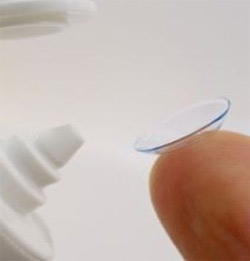
Washing hands with soap and water, allowing cases to air-dry, and using cases and disinfecting solutions from the same manufacturer are key steps to reducing contact lens contamination, suggests the report by Mark D.P. Willcox PhD, FAAO, and colleagues of University of New South Wales, Sydney.
Hygiene Habits Linked to Contamination of Contact Lens Cases
The study included 119 contact lens wearers, recruited at their optometrist’s office. Participants completed a questionnaire regarding their contact lens hygiene habits. They also provided used contact lens storage cases, which were sent to a laboratory for culture studies to assess contamination. Relationships between hygiene practices and contact lens case contamination were assessed.
As in previous studies, contamination rates were high: 66 percent of contact lens cases tested positive for bacterial or fungal contamination. In nearly 40 percent of contaminated cases, multiple organisms were isolated.
After adjustment for other factors, three specific hygiene habits were associated with higher levels of contamination:
Not washing hands with soap and water before handling contact lenses. Patients who used soap had lower contamination levels than those who washed their hands with tap water only, or who didn’t wash their hands at all.
Not air-drying the lens case.Contamination levels were higher in cases that were wet when received for testing.
Using mismatched lens cases and disinfecting solutions.Contamination was increased when patients used contact lens cases and disinfecting solutions from different manufacturers.
Contamination was also increased for patients who had worn contact lenses for two years or longer. That was consistent with previous studies suggesting that more-experienced wearers may become “less vigilant” with hygiene habits over time.
Contaminated contact lens cases may contribute to complications, including potentially serious infections. Many of the contaminants isolated from contact lens cases were bacteria commonly identified in minor corneal infections (infiltrates), Dr. Willcox and coauthors note. Bacteria linked to more serious infections (keratitis) were found in only one percent of cases.
“Lens cases play an essential role in disinfection of contact lenses,” comments Anthony Adams, OD, PhD, Editor-in-Chief of Optometry and Vision Science. “However, without proper maintenance, the lens case itself may become contaminated with micro-organisms during handling.” The researchers note that even eye care professionals aren’t always sure what lens case hygiene practices to recommend.
The new study highlights important hygiene habits to reduce contamination of contact lens cases — including washing hands with soap and water, air-drying lens cases, and using matching lens cases and disinfecting solutions. Dr. Willcox and colleagues add, “Other hygiene instructions that may be beneficial include replacing lens cases at least every time a new bottle of [disinfecting solution] is used, drying the lens case face down, and rubbing (using clean hands) the lens case to clean it.”